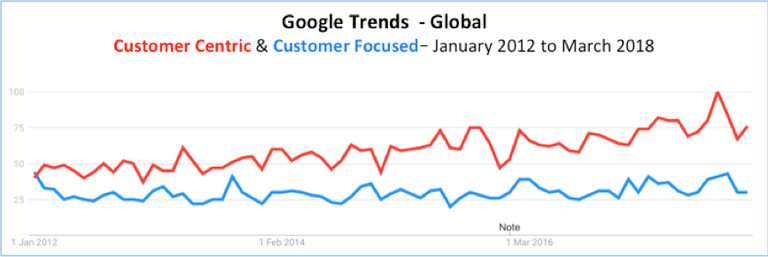Table of Contents:
I was recently asked about the difference between customer focused and customer centric. For many people, these two terms are almost interchangeable, but if you dig into the literature and advice, there are some subtle but important differences. This post looks at the differences between customer focused and customer centricity—and identifies where customer centricity is taking center stage.
Read now: The definitive guide to customer centricity
The trend in customer centricity, compared with customer focused, is illustrated by the data from Google Trends shown below.

Product Centric vs Customer Centric
The key change to keep in mind is that markets have moved from product centricity to customer centricity. Companies used to focus on design, manufacturing and logistics. In the days when products and services could achieve a clear product/service difference that was clear, sustainable and beneficial, a product-centric approach made sense. Today, we have informed consumers, competitive markets and few tangible product/service benefits—a combination that has resulted in the focus shifting to customers.
What is a customer focused approach?
A customer focused approach refers to running a business with an emphasis on meeting the current customer demands. Although this idea is not new, companies believe this focus on the customer needs leads to higher profits, however, it fails to look at the full picture.
While being customer-focused is important, it doesn’t cover enough ground to create the impactful experiences that today’s consumer expects.
What is the impact of customer centricity vs customer focused?
So, what is the difference between customer centricity and being customer focused, and why might you favor customer centricity? Here are five key points to keep in mind.
1. Thinking from a customer’s point of view
Customer-focused approaches tend to be based on looking at the customer and trying to work out what to sell to them. This is an outside-in approach. Customer-centric approaches try to see the world from the customer’s point of view, which is an inside-out point of view. Approaches like programmatic advertising, A/B testing and NPS metrics are customer focused. Approaches based on co-creation, ethnography, and motivations tend to be customer centric.
2. Deal with what customers need, not what they say they want
Customer-focused companies listen to what customers say they want and try to give it to them. Customer-centric companies try to understand what customers need and deliver that. The famous examples of Ford not wanting to provide faster horse-drawn carriages and Steve Jobs not asking customers how to develop the iPhone fall into this category.
3. Provide long-term solutions, not just products or services
Customer-focused marketing tries to identify which products and services match the wants from each customer. Customer-centric approaches try to create a complete solution. By thinking like the customer, by understanding needs as well as wants, a customer-centric company can ensure that the long-term experience of the customer is optimized.
4. Focus on Customer Lifetime Value
Customer-focused companies often focus on being nice to all their customers, offering great service to all customers and empowering frontline staff to go the extra mile to make the customer happy. Customer-centric companies know who the key customers are, because they employ an approach based on customer lifetime value. These companies typically have a segmentation that is based on customer lifetime value, and focus their efforts on the relationship with and needs of these customers. Other customers are still customers, but they are not central to the strategic planning of the business, nor to the creation of the key tactical tools.
5. Proactive Instead of Reactive
Customer-focused companies tend to chase the customer, seeking to please everybody who walks through the door and seeking to match the product/services on sale with each customer. Customer-centric companies are focusing on core customer groups, identifying needs (not just wants), and seeking to solve problems. This is a strategic approach and encourages the company to work with customers to co-create the future.
Peter Fader, author of Customer Centricity, summarizes the picture in the following way: "Customer centricity is a strategy to fundamentally align a company’s products and services with the wants and needs of its most valuable customers."
3 Customer Centricity Examples:
Here are three examples of customer centricity at work.
Best Buy
Ranjay Gulati reports how Best Buy talked to a group of customers (in this case "Busy moms") to find out why they were leaving the store without buying anything. One of the drivers of selecting this group was that women are involved in 55% of purchases from the store—i.e. they are a high-value group.
Best Buy discovered there was a mismatch between the sort of "customer focus" the sales team were offering and the actual customer needs. These "busy moms" wanted to look at complete solutions such as wanting to buy a digital camera that would allow them to share photos with family members. But the sales team were immediately diving into questions about the number of pixels the shopper wanted. By identifying important customer groups and then identifying customer needs, Best Buy was able to sell more stuff, and sell the right stuff. Gulati reports that the customer-centric layout that resulted from the initiative led to a 9% increase in sales.
Apple versus Nokia
In 2007, Nokia was the dominant mobile phone provider, with a global share of about 50%. Nokia had a great research program and was listening to what their customers wanted and seeking to satisfy all of their customers.
By contrast, Steve Jobs and Apple launched the iPhone, which addressed the needs of core future customers. The iPhone never reached a market share of 50%, but was massively profitable and fundamentally disrupted the mobile phone market—leading to the decline of Nokia. Although Apple does conduct market research, it has been successful by anticipating needs and by focusing on customer lifetime value among its core segments. Apple is customer centric, but it is not customer friendly or focused (unless you happen to fit one of their core groups).
Ryanair
Ryanair is a very successful low-cost airline in Europe. It is also rated very badly by industry satisfaction studies. In 2017 the Which survey rated it worst amongst 20 European airlines—while acknowledging that it was also Europe’s most popular airline (i.e. it had the highest number of customers).
Ryanair is not a customer friendly sort of brand, but it is customer centric. It flies lots of planes, reliably, to lots of destinations, at very low cost. Their target customers are the people whose needs are price, frequency and destination. These customers might "want" good food, pleasant customer service, free additions etc.—but they are not prepared to pay for it. Ryanair has succeeded by identifying and focusing on the needs of its customers, not by trying please everybody.
Adding A Customer Centric Strategy to Your Business
The first step is to start thinking strategically, and being proactive rather than reactive. Determine how you are going to focus on lifetime customer value, in particular, who your core customers will be. Focus on customer needs rather than wants (you will still research and respond to wants, but needs are key). Organize around providing solutions, rather than separate collections of products or services.
Decide how you are going to start seeing the world through the eyes of the customer, rather than just watching the customer.
Further Reading:
If you want to find out more about customer centricity, then I would recommend the following
- Customer Centricity: Focus on the Right Customer for Strategic Advantage, Peter Fader, 2012.
- Customer Centricity: Why It Is Critical To Your Business and How To Measure It, Gareth Evans, 2016.
- Foundations for Customer Centricity, James Dodkins, 2015.
- Reorganize for Resilience, Ranjay Gulati, 2009.
- Winning Customer Centricity, Denyse Drummond-Dunn, 2015.
Note: A version of this article first appeared on NewMR.org.






